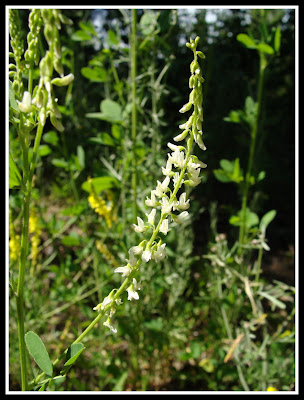Right now the wild Clover is blooming all over the Parkarosa. I took pics of the ones growing closest to the house. The variety is astounding. These are just a few. They all have the 3 leaflet style leaves on them. But the flowers are unique for each variety. Please click on the pics to get a more detailed view.
I call this lawn clover because it grows in our lawn but technically it's White Clover (Trifolium repens).
It came with the grass seed, so I guess technically it's not wild.
This is a Least Hop Clover (Trifolium agrarium). Each plant stands straight up, 6 to 8 inches high, and the flowers are about half an inch across. Notice the leaves are thin.
This is another yellow clover. I've been unable to find it's name. At first I thought it was the same as the above yellow clover because they are living right next to each other all mixed up in the woods, but it's actually a totally different species. It's flowers are teeny tiny and much more complex in structure. Until I saw this photograph, I had no idea it was this fascinating. The leaves are much rounder. It gets to about 6 inches tall maximum but mostly it grows along the ground spreading tendrils out like a ground cover.
This is called Red Clover (Trifolium pratense), though it looks purple to me. These flowers get up to an inch in diameter and grow 2 feet tall.
I love the colors in this Pink White Clover (Trifolium repens). So bright and feminine. It stands about 12 to 18 inches tall and the flowers are about 3/4th inch across.
This is called Yellow Sweet Clover (Melilotus officinalis). It grows very tall. I've got pictures of my husband standing in a patch that grew 10 feet tall one summer, but most of the time it's between 4 and 5 feet tall.
The flowers themselves are about 4 to 6 inches long. It smells wonderful! The air is thick with a sweet and tropical odor when it's in bloom.
This is White Sweet Clover (Melilotus alba Medi). It has the same basic structure of the yellow, just a different color. This is NOT an albino of the yellow. It is it's own species. What's very interesting is that some years yellow dominates the landscape and other times white dominates it, all depending on what kind of winter and spring we have. If spring is early and a bit dry, we get lots of white Sweet Clover. If spring is cold and wet, we get lots of yellow Sweet Clover.
I hope you have enjoyed my little article on the clovers of the Parkarosa.
Live long and prosper. \\//









Wow, a weed is not always a weed right? Thanks for the lesson Linda!
ReplyDeleteThe other yellow clover looks to me like black medick (Medicago lupulina), though there are a few little yellow clover-headed pea flowers that all look very similar.
ReplyDeleteNice post :)
Thank you Karl. The identification is much appreciated.
Delete